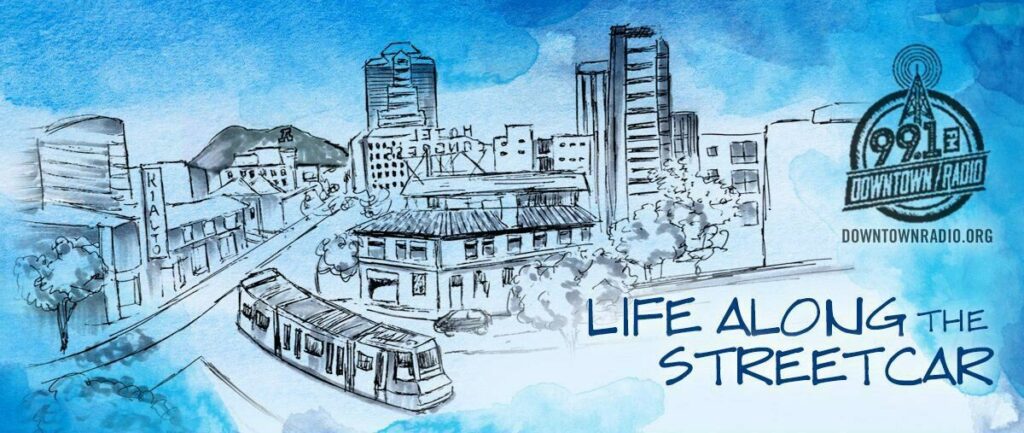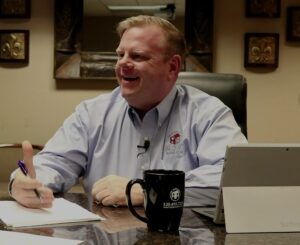
This week we discuss a Chinese grocery empire in Tucson and how they thrived in the heart of Barrio Viejo.
Each and every Sunday our focus is on Social, Cultural and Economic impacts in Tucson’s Urban Core and we shed light on hidden gems everyone should know about. From A Mountain to the U of A and all stops in between. You get the inside track- right here on 99.1 FM, streaming on DowntownRadio.org- we’re also available on your iPhone or Android using our very own Downtown Radio app.
Reach us by email [email protected] — interact with us on Facebook at LifeAlongTheStreetcar and follow us on Twitter @StreetcarLife
Our intro music is by Ryanhood and we exit with Ted Ramirez
Today is August 18th, my name is Tom Heath and you’re listening to “Life Along the Streetcar”. We start today with 244 candles on a big cake.
The Chinese Grocer and a Mariachi Band - Feature Interview with Sandy Chan
For 100 years, 4 generations of the Lee family operated a grocery store at 600 S Meyer, in Barrio Viejo. They are among the rich history of Chinese impact in Tucson. Next Friday in that same spot, which has been revitalized and now houses offices and a space for presentations, there will be talk about this impact on our community. The speaker is Sandy Chan, retired Faculty Librarian at Pima Community College, former President of the Arizona State Genealogical Society and lead on the Tucson Chinese history lab in collaboration with the Arizona Historical Society’s Library & Archive. She is the author of the article “The Incredible Life of Ah One: Tucson’s Chinese Sailor”, published in the Journal of Arizona History.
We had a chance to with Sandy inside the former Lee Ho Market and talk about an important part of Tucson history.
Transcript
Tom Heath: Good morning Tucson. It’s a beautiful day in the Old Pueblo. And I want to thank you for spending a part of your brunch hour with us on your downtown Tucson community sponsored Rock n Roll radio station. This week, we discuss a Chinese Grocers empire in Tucson and how the family thrived in the heart of Barrio Viejo.
Tom Heath: Each and every Sunday, our focus is on social cultural and economic impacts in Tucson’s Urban core and we shed light on hidden gems. Everyone should know about. From A Mountain to the U of A and all stops in between, you get the inside track right here on 99.1 FM streaming on DowntownRadio.org, also available on your iPhone or Android using our very own Downtown Radio app. Just wanna head over to the app store or Google Play and get Downtown Radio Tucson and make sure you get that Tucson part or else you’ll get a Downtown Radio in Ireland, I think.
Tom Heath: Well, if you want to get us here on the show in contact us with our email LifeAlongTheStreetCar.org. It’s [email protected]. We’re over on Facebook at Life Along the Streetcar and on Twitter our handle is StreetcarLife.
Tom Heath: Well today is August 18th. My name is Tom Heath and you’re listening to Life Along the Streetcar. We are gonna start the show with 244 candles on a really big cake. Well, it is the birthday of Tucson coming up this week in there couple of celebrations we wanted to highlight for you in case you wanted to go check them out and celebrate with the rest of Tucson.
Tom Heath: There’s one kicking off today and actually starting right now as a matter of fact at the Southern Arizona Transportation Museum. It’s a multicultural event and there will be music dancing other festivities representative of Tucson’s culture. There’s the Chinese lion dance. There’s going to be Mariachis. Ted Ramirez will be there. He does American Mexican folk music. They’ll be Buffalo Soldiers on hand as well as some other band playing some music.
Tom Heath: That all kicks off at 11:30 at the Southern Arizona Transportation Museum. It’s in the historic Amtrak Tucson train depot, North Toole there 400 North Toole. You may know better as the Maynard’s Plaza. There, Maynards is on one end Transportation Museum is on the other.
Tom Heath: If you can’t make it today head over to the Presidio Museum on Tuesday, Tucson’s actual birthday, the 20th. There’s going to be again performances very similar theme of multi cultural importance of Tucson. Buffalo Soldiers will be there. The Chinese Cultural Center have a presence as well as folks from Mission garden and Old Pueblo archaeology. And I understand they’re all be some presentations from the Ignite Sign Museum, which has a very good take on Tucson’s neon history. So again today, Southern Arizona Transportation Museum, 400 Toole in the Old Historic Depot and on Tuesday, you can head over to the Presidio Museum starts at 4:45. Well the gates open at 4:45, performances will start around6pm and both of these events are free. The one on Tuesdays at the Presidio Museum, which is in the heart of downtown.
Tom Heath: Fun stuff and a lot of similarities and it’s interesting to note that they are both celebrating the Multicultural aspect of Tucson’s history. And that is appropriate for our show today. For a hundred years, four generations of the Lee family operated a grocery store at 600 South Meyer in Barrio Viejo. They are among the rich history of Chinese impact in Tucson and next Friday in that very spot, which has since been revitalized and now houses a space for presentations as well as offices.
Tom Heath: There’s going to be a talk about this impact on our community and the speaker is Sandy Chan. She’s retired faculty librarian at Pima Community College, is a past president of the Arizona State genealogical society, and she was lead on the Tucson Chinese history lab in collaboration with the Arizona historical society’s library and archive. So she knows her stuff. She’s a published author of the article The Incredible Life of AH One, Tucson’s Chinese sailor. We had a chance to sit down with Sandy. Inside the former Lee Ho Market, and talk about this important part of Tucson’s history.
Sandy Chan: There was a gentleman that lived in Tucson by the name of George Hand. George Hand’s claim to fame was that he kept a diary and George Hand’s Diary of Tucson is one of the best references for Tucson in the 1870s and the 1880s. And in that diary, he mentioned that he went to eat at the China restaurant. And that’s the first documentation we have of the Chinese in Tucson.
Sandy Chan: Now, of course, the Chinese had to be around for a while to, you know, develop the restaurant to see there was a market for a restaurant. It wasn’t a Chinese food restaurant, the original Chinese restaurants made American food for American customers. They were cooked by Chinese people. And about six months later, there was an advertisement that appeared for a restaurant called the Celestial Restaurant and they believe that that was the same restaurant that George Hand ate at. So the restaurant was doing well enough that it was advertising in the local paper.
Sandy Chan: By 1880, January of 1880 Advanced parties from the railroad came through Tucson by May or by March of 1880 the Union Pacific Railroad reached Tucson and by the end of the year the railroad had moved on out of Southern Arizona into New Mexico, and there was about Eleven Hundred Chinese on the railroad Crews that came through Southern Arizona that’s was like a village on Wheels.
Sandy Chan: And so that really kind of opened up Tucson and there wasn’t a huge Chinese Community.
Tom Heath: You have 1100 and this Caravan kind of moving in with the rails and expanding the the railroad. Is it natural that of that 1100 some chose to stay? Hey Tucson, this is my place?
Sandy Chan: There may have been a few two sons Chinese Community was never very large. There was a hundred and twenty some odd Chinese in Tucson in the 1880 census, which was done in June. I believe now the first important Chinese person in Tucson was named Chan Tian Wu. Chan Tian Wu had been working on the railroad up in Maricopa, and there was a trial in Tucson that he was asked to come and be an interpreter in, and he did.
Sandy Chan: By 1880, he was in Tucson and he opened the first Chinese market in Tucson. He was enormously successful. He was very unusual. He became an American citizen before the exclusion took place in nineteen or 1883 the exclusionary act. He married a Chinese woman from Los Angeles, which is incredibly unusual because most Chinese men got their wives from China.
Sandy Chan: He was the first Chinese American to serve on a jury. He he voted the critical vote to establishing the dreckman school, which was just down the road here on 18th and Convent. I think it is now the LaLo Guerrero Barrio Viejo senior housing if I remember correctly, but that was chanting woke and he voted he was on the voter rolls, but he was an incredibly successful man who was a role model for the other Chinese Merchants who came into town.
Tom Heath: Chinese Merchants, that seems to be a common theme that that was a very prolific way of making money for the change culture in Tucson. Is that fair to say?
Sandy Chan: Yes it is and I believe the reason that it was that it was so profitable for the Chinese in Tucson and what carried the Chinese through many decades Tucson’s Chinese communities incredibly unusual because Does it still exist and that’s because they found a very profitable Niche within the Hispanic community.
Sandy Chan: So they would set up markets in areas like Barrio Viejo to sell Goods to the Mexican Community to the Mexicans that lived in the area. This was very profitable and it was safe because they didn’t interface as much with the Western Society who truly hated the Chinese. Took about 25 years, but after about 25 years more and more the Chinese merchants started bringing their wives and some of them brought children from China.
Sandy Chan: When they did that they started literally putting Roots into the Tucson Community because you would have the Chinese Merchants who spoke Spanish to their customers their children would go to go to school with the Hispanic children. They would mix together and play in the street. the Chinese never lost their Chineseness, but they did acquire some Mexican traits, I guess that’s the best word. They, my mother-in-law for example who was born here in Tucson in the mid-1920s. Grew up speaking Spanish Chinese and English. She grew up making Chinese food Mexican food. She made very good tamales and American food. She lived in an incredibly Rich Multicultural community that the Chinese adapted to.
Tom Heath: This upcoming Friday, you’re actually doing a presentation and focusing on that 1870 through 1960 period Tucson’s history. What’s significant about 1960?
Sandy Chan: The end of 1960, they had a urban development that tore down Barrio Viejo South of Broadway and they built what’s now the community center and when they did that they wiped out a structure some people refer to it as Chinatown. I prefer to call it the tong That was the center of the Chinese community in Tucson.
Sandy Chan: It was the Chinese poor house, which is where mostly elderly Chinese men who could not get back to China lived. They had the Chinese Chinese Chamber of Commerce was stationed there and the 20s and 30s. I actually up to the 50s. They had the cooming Tang which is the Nationalist Chinese party had an office there. They had a giass house which is a temple any major Chinese holiday like Chinese New Year or always celebrated at this at this building.
Sandy Chan: The building was incredibly significant because it was built as by one of tiny by one of Tucson’s early Jewish Merchants, who was an in-law of the Steinfelds and Stuckendorfs. So it was an incredibly historic area that just got raised and they built the community center where it is.
Tom Heath: We’re listening to Sandy Chan. She’s retired faculty librarian at the Pima Community College past president of the Arizona State genealogical society. And author of The Incredible life of 01 Chinese Tucson’s Chinese sailor, which was published in the Journal of Arizona history and we’ll be right back to that interview and just a few moments.
Tom Heath: We heard earlier about the impact of Chinese culture in Tucson, and we’re going to return to the second half of our interview with a Sandy Chan who will be presenting a lecture this Friday on Chinese history and Tucson from 1880 to 1960. She’s doing that presentation in the recently rehabilitated and revitalized space that once held Jerry’s Lee Ho Market, 600 South Meyer and we talked more specifically about that location and about the Lee family here in Tucson.
Sandy Chan: Earliest I’ve been able to place a building being here and I think it was here before 1881 at that time. It was a Mexican owned. There was a woman who lived here who was a barkeeper in 80 and the 1881 city directory. By 1899 it had a Chinese tenant by the name of lung sing. So long sing is the patriarch of the Lee family here in Tucson Long Sing.
Sandy Chan: Unfortunately was murdered in 1915. He was attacked and stabbed. This was not unusual many Chinese Merchants were killed in their stores, people working on their own and isolated circumstances or frequently robbed and that’s what happened to him. His son Lee Ho took over in about 1915. By the 1940s Lee host son. Jerry Lee became involved with the business 1949 his father Lee ho dies and Jerry takes over store. And Jerry was one of these people you just wonder how did he ever have time to sleep? I mean, he was such an active man. He had six children.
Sandy Chan: I believe he not only ran the store here this store and in this community he would have and this is so funny that we’re doing radio broadcast because I know in the 1940s they had radio broadcasts from the store.
Tom Heath: So out of Jerry Lee Ho’s store they were doing they were doing radio broadcast.
Sandy Chan: Through KVOA, and that’s where we are!
Tom Heath: In the building, it says 600 South Meyer and do you know much about the history of the building recently? Because I know at one point this was after became a grocery, but it was a vacant and abandoned and it almost it was at the point of collapse, I think at some point.
Sandy Chan: It was sold Jerry Lee, Jerry Lee continued on with his he had Mariachis that they would close down the streets and We have Mariachis bands come in. He was members of boards. He owned juries Ming house, which I think was two sons first, ethnically truly ethnic Chinese restaurant was Jerry Lee and by 1999 Jerry Lee had passed away in California.
Sandy Chan: Well by that time the store had kind of run down a little bit. He really hadn’t been here for quite a while and it was purchased by believe a couple from Canada. They did try to continue running it as a grocery store, but it just really didn’t work very well and then I think it was sold to a who ran it as a restaurant and what they did was they had a patio on the roof.
Tom Heath: This was the building with the patio at the big glass. Yes. Yes. Okay. Yes.
Sandy Chan: Unfortunately the building was not built for that and that then had to end after a few years. I think the city stepped in and said they could What do that purchased by a country company and it was remodeled into what we see now.
Tom Heath: Well it’s been remarkably restored. Its this piece of Tucson that it’s what excites me the most when you’ve got the historic brick wall with sort of the modern interior, but you’ve got the old and the new really sort of join together here.
Sandy Chan: And very interestingly, the facade on this that they’ve done with the brick wall. There’s a picture in 1947 advertisement for Jerry for a lethally host or that shows a facade very similar to this and they had all of these neon lights on it. I mean this thing must have lit up like a, you know, a birthday cake at night and so they’ve stripped back the kind of art deco later facade the modern one that had the aqua tiles and it was kind of front they had to kind of a flat front. But they’ve pulled it back to something more 1930s, 40s.
Tom Heath: Okay. And do you know much about the mural that’s on the north wall?
Sandy Chan: You know, I don’t I think it’s a wonderful mural because not only does it bring in the Chinese Grocers. You’ve got Lalo Guerrero. You have some skeleton for the Day of the Dead.
Tom Heath: It’s certainly representative of a Barrio Viejo in a community. Yes, not just the grocery aspect of it. There’s two gentlemen in the center, do you know, if one of those is Jerry Ho?
Sandy Chan: The one with the hair, I think is Jerry Lee and then his father is Lee Ho. And the reason Lee Ho’s name has his last name first is because he was very traditional Chinese. So he used his last name first. Whereas Jerry, the Modern Man used his Chinese last name as an Americanized last name.
Tom Heath: Well, when we originally scheduled this interview, my thought was I could give a little promotions to your talk coming up on Friday. But I understand it’s sold out. So I would still recommend people check out the link on the website and we’ll put the link on our Facebook page because it’s part of a series called the Now Series and Night Out With… and that’s actually in the background who’s organizing all of this stuff, but they’re different speakers that are coming in to this area into this facility because now it’s being used for a community center of sorts for small presentations like this. I think that’s probably pretty appropriate I would imagine is a grocer. This was a gathering spot for the community?
Sandy Chan: This was a gathering spot for the community. Groceries., not just Chinese groceries but groceries, for example, if you didn’t have a regular address you could get your mail delivered to the grocery store and they would hold your mail. You could have the grocer what holds your money if you didn’t want to go to the bank and you didn’t want to keep it under your bed the grocer would hold money for people.
Sandy Chan: We talked about Jerry Lee and the Mariachi’s out here, which I think is a wonderful, you know, you could see how close this is. I’m sure everybody for blocks around could hear it. So there is a lot of people getting to know people. The Chinese Grocers were known for their willingness to give people credit which made a huge difference in the lives of many people.
Tom Heath: Interesting, there’s something, someone, some event that really should be a part of Tucson’s history of little bit more known about Tucson’s history?
Sandy Chan: These were goal-oriented hard-working people and what they did was they kind of moved out of the grocery business into other aspects of society. And for example, my husband’s grandfather started the groceries, his son was a grocer but none of his grandchildren for Grocers. My husband has cousins whose father started a grocery his son became I’m the first Chinese dentist in Tucson.
Sandy Chan: The unusual thing about the Lee family is there’s a full four generations of successful Grocers at this site in the family. They just happen to find a very profitable and well-run business for four generations 100 years their ability to adapt to a new culture their hard work was appreciated. They found a niche that people needed. Very very interesting very interesting story here in Tucson
Tom Heath: Very interesting story indeed and I think we are just at the very beginning of that story our feature last week with the Mercado. We ran into this impact of the Chinese culture and that area so I believe we’ve got many more stories to do.
Tom Heath: We were listening to Sandy Chan. She is the former president the Arizona genealogical society and was the lead on Tucson Chinese history lab in a collaboration with the Arizona historical society’s library and archive. I also invite you to head over to our Facebook page after the show to learn more about her presentation this Friday August 23rd, and then you want to link to Ru Events who is the organizer of the Now Series Night Out With.
Tom Heath: These are presentations about Tucson’s history and they’re taking place for the most part in this location at 600 South Meyer. Well, my name is Tom Heath and you’re listening to Life Along the Streetcar on Downtown Radio 99.1 FM. And available for streaming on DowntownRadio.org.
Tom Heath: We hope you enjoyed episode 97. We had a look at some of the birthday celebrations for Tucson’s 200 and a 44th birthday. One of those is on Tuesday at the Presidio Museum. And there’s one happening right this moment at the Southern Arizona Transportation Museum.
Tom Heath: I’m going to try to head over there and grab a little piece of cake before that’s all gone. That’s at the historic train depot. Both of these events are featuring The Multicultural history of Tucson and it’s very appropriate then that we had Sandy Chen on today talking about her presentation coming up this Friday about Chinese history and Tucson from 1880 to 1960 if you want to see if there’s any tickets available, you can have a our Facebook page will link to the site there.
Tom Heath: Although I think they’re sold out there might be one or two left while you’re there though. Check out. The whole now series night out with series. That’s put together by root events. They’re going to have different speakers and topics that I’m finding pretty darn interesting and you might as well.
Tom Heath: And if there are topics that you would like us to share on the show, we’ve got some time together each week on Life Along the Streetcar. Let us know, shoot us an email [email protected]. Tag Us and something on Facebook, shoot us a direct message or hit us up on Twitter and we’ll be glad to investigate and get those stories on the air. Our job is to uncover hidden gems in Tucson’s urban core. We need your help with that.
Tom Heath: Next week very interesting show that sort of a dovetail into today’s the space. We are at 600 South Meyer the location of this presentation on Friday. It’s a space that’s being used by a couple of entrepreneurs startups here in Tucson Catina color and Gina Catalano. They have put together a co-working campus not just a co-working office but a co-working campus that includes the former Jerry Lee Ho market and also the there’s a building on Simpson which they’re using and they’re in the process of renovating loss of Prima Tortilla Factory, which is just a couple blocks north of Jerry’s Lee Home Market.
Tom Heath: So all of this are going to be used for community events co-working spaces collaboration and we get to talk with Katina about the impact of Co-working on a just a general age of Entrepreneurship and how that collaboration leads to more opportunities in our community also had a chance to talk to her about what the impact is for keeping some of the Millennials in the college graduates that we’ve heard are leaving Tucson. How do we keep them here in in town and keep their brain power here? So I’m going to put over interview next week with Katina. And
Tom Heath: finally a reminder that September 7th, it’s hard to believe it’s coming up this fast, but the Tucson Trolley Tours kicks off, talked about it last week. This is a venture that I’m involved with its from 9:00 to noon every Saturday. We’re going to leave for the Mercado Annex we’re going to do a three-hour tour of downtown central you of a area the historic and cultural significance of much of that area and talk about some of the cool things that you might not find if you’re just Googling Tucson. We want to get you into those hidden gems and physically take you there.
Tom Heath: That website is TucsonTrolleyTours.com. If you want more information to check it out there are costs involved and there is limited space. So head over to either our Facebook page or the website to check out more information. Well, I appreciate you being a part of it. We are quickly approaching episode number 100. So it’s been a pleasure to present this information to you for the last couple of years and appreciate all of the feedback.
Tom Heath: We’re going to wrap up today’s show with some music by Ted Ramirez. He is the official Troubadour of Tucson. He has a south-west folk music style and specifics in both Spanish and in English. He’s going to be performing at the Southern Arizona Transportation Museum in just a few moments. He’ll be there live and you can go over there and hear him as part of the birthday celebration and in my mind, I kind of imagined Jerry’s Lee Ho Market back in the day people coming and going and bringing the live entertainment.
Tom Heath: We had mariachis in the street. Maybe someone like Ted Ramirez was there in the corner singing out some songs. Maybe even this one La Dona Del Puebla. My name is Tom Heath and I hope you have a fantastic week. Celebrate Tucson’s birthday and then tune in next Sunday for more Life Along the Streetcar.



